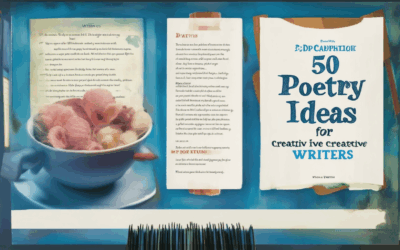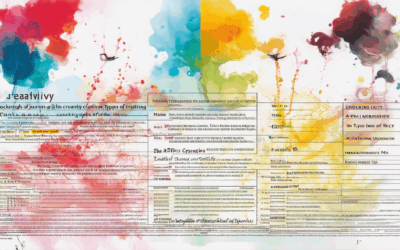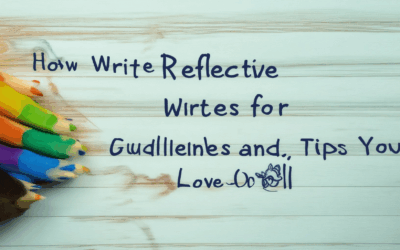Everyone has a poet within them, waiting to emerge and share their unique perspective on the world. Poetry for creative expression is more than just words on a page—it’s a powerful medium that connects us to our emotions, thoughts, and experiences. Whether you’re a seasoned writer or someone exploring creative writing for the first time, poetry offers a transformative way to express yourself authentically. From finding inspiration in everyday moments to crafting verses that resonate deeply, this guide will walk you through the ins and outs of poetry for creative expression, helping you unlock your inner poet and discover the beauty of self-expression.
Key Takeaways
– Discover your inner poet and unlock your creativity through poetry.
– Use poetry as a powerful tool for emotional release and self-expression.
– Experience personal growth by telling your story and reflecting deeply.
– Find stress relief and mental well-being through the therapeutic act of writing.
– Connect with others and inspire shared experiences by sharing your poetry.
– Explore various poetry forms to expand your creative horizons.
– Develop a unique style and find your voice in the world of poetry.
– Start small, begin with simple verses, and build your skills gradually.
– Embrace experimentation to evolve your poetry and grow as a writer.
– Share your poetry to inspire others and foster a vibrant creative community.

How to Write Poetry for Self-Expression
Writing poetry is a powerful tool for self-expression, allowing individuals to capture emotions, experiences, and thoughts in a creative and meaningful way. Below are some steps to help you get started:
- Find Your Inspiration: Pay attention to the world around you. Observation is key—notice patterns, emotions, or moments that stand out. Keep a journal or notebook handy to jot down ideas whenever they strike.
- Experiment with Forms: There are many types of poetry, such as sonnets, haiku, free verse, and rhyme schemes. Try different styles to see what feels natural to you. Explore themes that resonate personally, whether it’s love, loss, nature, or identity.
- Develop a Routine: Consistency helps build momentum. Set aside time daily or weekly to write. Even five minutes a day can make a difference over time.
- Seek Feedback: Share your poetry with trusted friends or join writing groups. Constructive criticism can help you grow and refine your work. Remember, feedback is a gift that can guide your progress.
- Edit and Refine: Poetry isn’t just about spilling your thoughts onto paper. Edit to remove distractions and tighten your language. Consider reading your work aloud to hear how it sounds.
Tips for Success:
- Read Widely: Immerse yourself in great poetry. Read works from various cultures and eras to expand your perspective and find inspiration.
- Join a Community: Become part of a poetry group or online forum. Engaging with others who share your passion can provide motivation and support.
- Stay Curious: Always ask questions. What does your poetry mean to you? How can you express it in a way that resonates with others?
Silken Drum encourages everyone to explore their creative sides through poetry. Whether you’re sharing personal reflections or telling a story, writing poetry is a journey of self-discovery and growth. Embrace the process, and let your words flow naturally.
What Makes Good Poetry in Creative Writing?
Good poetry in creative writing is defined by its ability to evoke emotion, tell a story, or convey a unique perspective through carefully crafted language and structure. Here are the key elements that make poetry stand out:
- Imagery and Metaphor : Effective poetry uses vivid imagery and metaphors to paint pictures in the reader’s mind. These elements transform abstract concepts into relatable experiences, allowing readers to connect deeply with the content.
- Structure and Form : The choice of poetic form, such as sonnets, haiku, or free verse, plays a crucial role in shaping the poem’s rhythm and flow. A well-chosen structure enhances readability and gives the poem a cohesive framework.
- Thematic Depth : Good poetry explores universal themes like love, loss, identity, or nature, offering fresh insights or unique takes on familiar subjects. This thematic richness resonates with readers on a personal level.
- Emotional Resonance : Poetry that moves readers often delves into the subconscious, expressing complex emotions that words alone might struggle to capture. This emotional connection creates a lasting impact.
- Rhythm and Rhyme : While not every poem needs a strict rhyme scheme, a well-crafted rhythm enhances the musicality of the language, making the poem easier to enjoy and remember.
Community and Inspiration
Poetry thrives in community. Platforms like Silken Drum provide spaces for writers to share their work, engage in discussions, and learn from others. This collaborative environment fosters growth and innovation, ensuring poetry remains a dynamic art form.
By focusing on these elements, writers can craft poetry that is not only meaningful but also impactful, connecting with readers in profound ways.

What is Creative Writing Poetry?
Creative writing poetry is a form of artistic expression that combines imaginative storytelling with lyrical prose. Unlike traditional poetry, which often focuses solely on rhythm and rhyme, creative writing poetry allows writers to explore deeper themes, emotions, and narratives through poetic devices while maintaining a storytelling element.
Purpose of Creative Writing Poetry
The primary goal of creative writing poetry is to evoke emotion, inspire thought, and convey unique perspectives. Poets use imagery, metaphors, and symbolism to paint vivid pictures in the reader’s mind, allowing for a deeper connection between the writer and the audience.
Forms of Creative Writing Poetry
Creative writing poetry can take various forms, including:- Lyric Poetry : Short, expressive poems that capture a moment or emotion.- Narrative Poetry : Tells a story through poetic means, often with a clear narrative arc.- Sonnet : A traditional form with a specific rhyme scheme and structure.- Haiku : A Japanese form emphasizing nature and seasons, focusing on brevity and imagery.
Examples of Creative Writing Poetry
Poetry like “The Road Not Taken” by Robert Frost or “Where the Wild Things Are” by Maurice Sendak exemplifies creative writing poetry by blending storytelling with poetic elements. These works invite readers to reflect on universal themes and personal experiences.
Platforms for Sharing Poetry
Silken Drum is an online platform dedicated to celebrating and supporting creative writers, poets, and literary enthusiasts. It offers a space to share work, explore imaginative content, and engage in community-driven discussions. Through blog posts featuring poetry, short stories, and reflective essays, Silken Drum fosters a nurturing environment for creativity and expression.
Tips for Aspiring Writers
To improve your poetry skills, consider: – Reading widely to understand different styles and techniques. – Practicing regular writing exercises to develop your voice. – Joining writing communities like Silken Drum to gain feedback and inspiration.
Competition and Neutrality
While Silken Drum supports various platforms, it remains committed to representing itself professionally. Competitors like Poetica and The Poetry Society offer valuable resources and opportunities, and we acknowledge their contributions to the field without bias.
By embracing the versatility and depth of creative writing poetry, writers can craft pieces that resonate deeply with readers and inspire meaningful connections.

What is a Creative Expression?
Creative expression refers to the act of expressing ideas, emotions, or thoughts in a unique and imaginative way. It encompasses a wide range of activities, including art, music, writing, dance, design, and more. At its core, creative expression allows individuals to communicate their inner world externally, providing a therapeutic outlet and a means of self-discovery.
Forms of Creative Expression
- Visual Arts: Painting, drawing, sculpture, and photography are common ways to express creativity.
- Performing Arts: Dance, theater, and music are dynamic forms of creative expression.
- Literary Arts: Writing poetry, prose, or scripts taps into creative expression through words.
- Culinary Arts: Creating unique dishes or designing menus can also be a form of creative expression.
The Benefits of Creative Expression
- Emotional Release: Expressing oneself can help process and manage emotions effectively.
- Personal Growth: Engaging in creative activities often leads to self-awareness and personal development.
- Stress Relief: Many find that creative expression reduces stress and promotes mental well-being.
- Connection with Others: Sharing creative works can foster connections and inspire others.
Fostering Creativity
Silken Drum is a platform dedicated to celebrating and supporting creative expression. We encourage writers, poets, and artists to share their work and engage in meaningful conversations. Explore our site to discover inspiring content, join discussions, and connect with fellow creatives. Visit Silken Drum today to dive into the world of creative expression.
The Three Main Types of Creative Expression
Creative expression encompasses a wide array of forms through which individuals can articulate their ideas, emotions, and perspectives. Below are the three primary categories of creative expression, each offering unique ways to convey artistic and intellectual concepts:
- Visual Arts
- Visual arts encompass a diverse range of mediums that allow creators to express themselves through imagery and design.
- Examples include painting, sculpture, photography, architecture, and digital art.
- These forms often rely on spatiality and composition to communicate ideas, making them deeply personal and universally accessible.
- Silken Drum celebrates these visual expressions through its platform, fostering a community of artists who share their work and inspire others.
-
Literary Arts
- Literary arts involve the creation of written works, ranging from poetry and prose to plays and essays.
- This form allows authors to delve deeply into narrative, reflection, and storytelling, offering readers a window into the creator’s mind.
- Platforms like Poets.org highlight the importance of literary expression, showcasing how words can evoke emotion and provoke thought.
-
Performing Arts
- Performing arts include dance, theater, music, and circus arts, where movement, dialogue, and sound combine to tell stories and convey emotions.
- These forms require collaboration and precision, bringing together various elements to create a cohesive experience.
- Performances often leave a lasting impression, blending tradition with innovation to captivate audiences.
Each of these categories plays a vital role in enriching our cultural landscape, providing diverse channels for human expression and fostering connections between creators and their audiences. By exploring these forms, individuals can find their unique voice and contribute to the dynamic tapestry of global creativity.

How to Make a Creative Expression
Creating a creative expression can be a rewarding process that allows you to explore your imagination and communicate your thoughts in unique ways. Here’s a step-by-step guide to crafting a meaningful creative expression:
- Choose Your Medium: Decide whether you want to express your creativity through art, writing, music, dance, design, or another form. Each medium offers a different avenue for self-expression.
- Find Inspiration: Look at works from artists, authors, musicians, or other creators who inspire you. This can give you ideas and a direction for your own expression.
- Develop Your Style: Identify what makes your work unique. Whether it’s a signature color palette, a particular technique, or a recurring theme, consistency helps others recognize your style.
- Start Small: Don’t wait for perfection. Begin with simple sketches, drafts, or experiments. Building a foundation is key to growth.
- Experiment and Evolve: Try new techniques, materials, or perspectives. Embrace mistakes as part of the creative journey. Over time, your style will become more refined.
- Share Your Work: Once you’re ready, showcase your creation to others. Sharing can provide feedback, new opportunities, and a sense of accomplishment.
Remember, creativity knows no bounds. Whether you’re painting, writing, or designing, the most important thing is to let your passion shine through. Explore, experiment, and enjoy the process!
For more resources and inspiration, visit Silken Drum , a platform dedicated to fostering creativity and connecting artists with like-minded individuals.




0 Comments